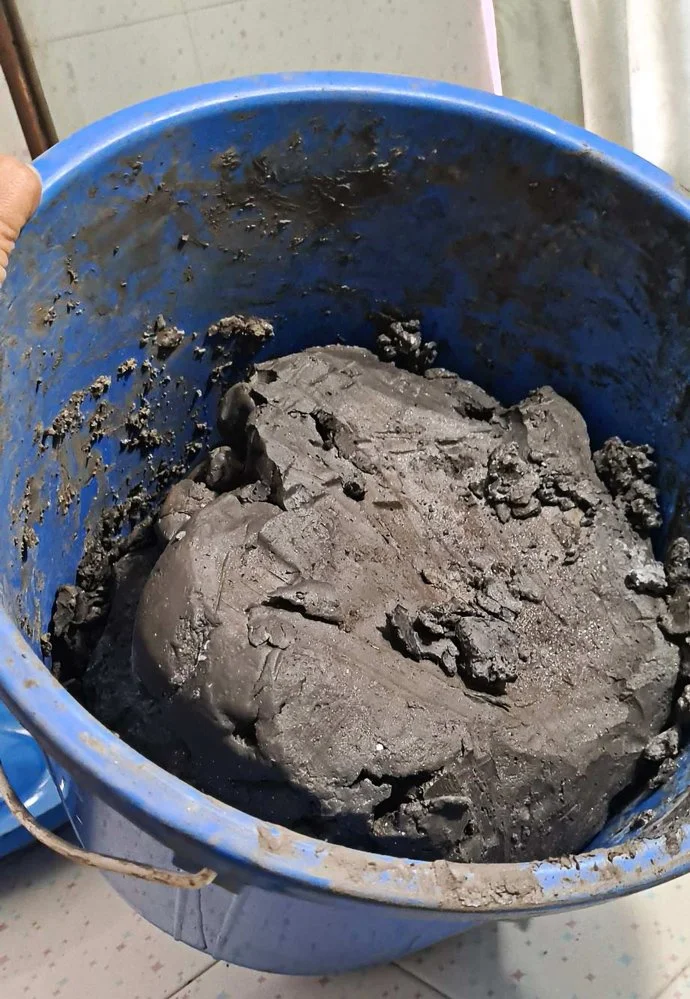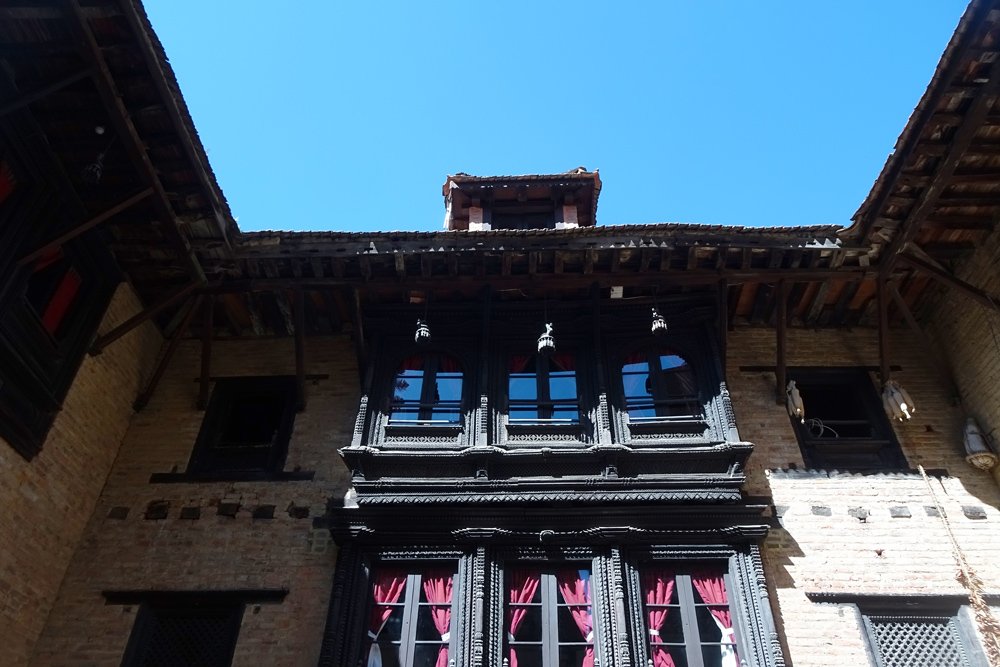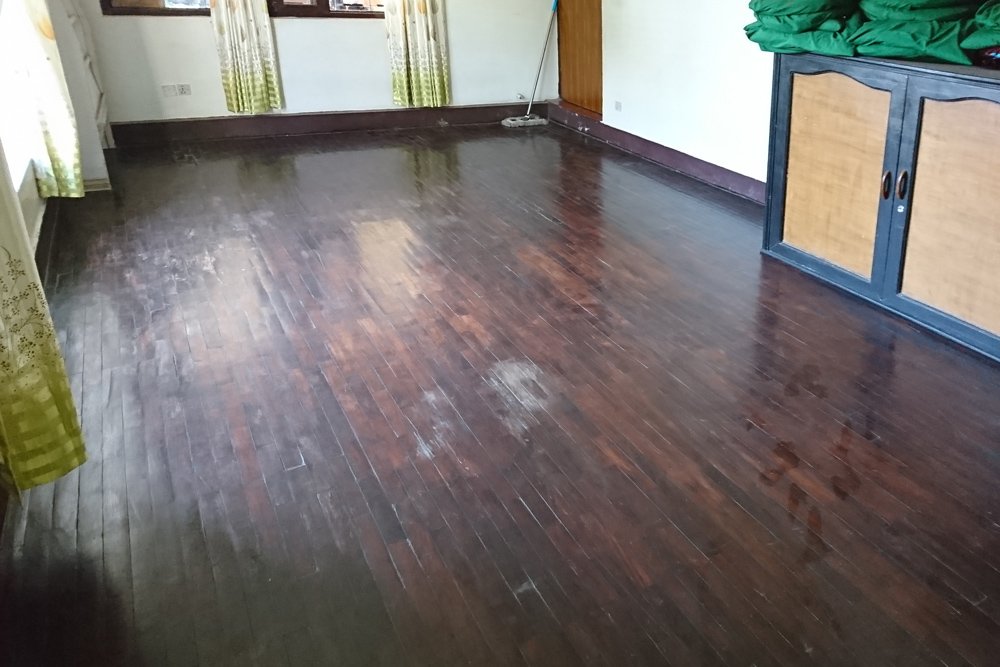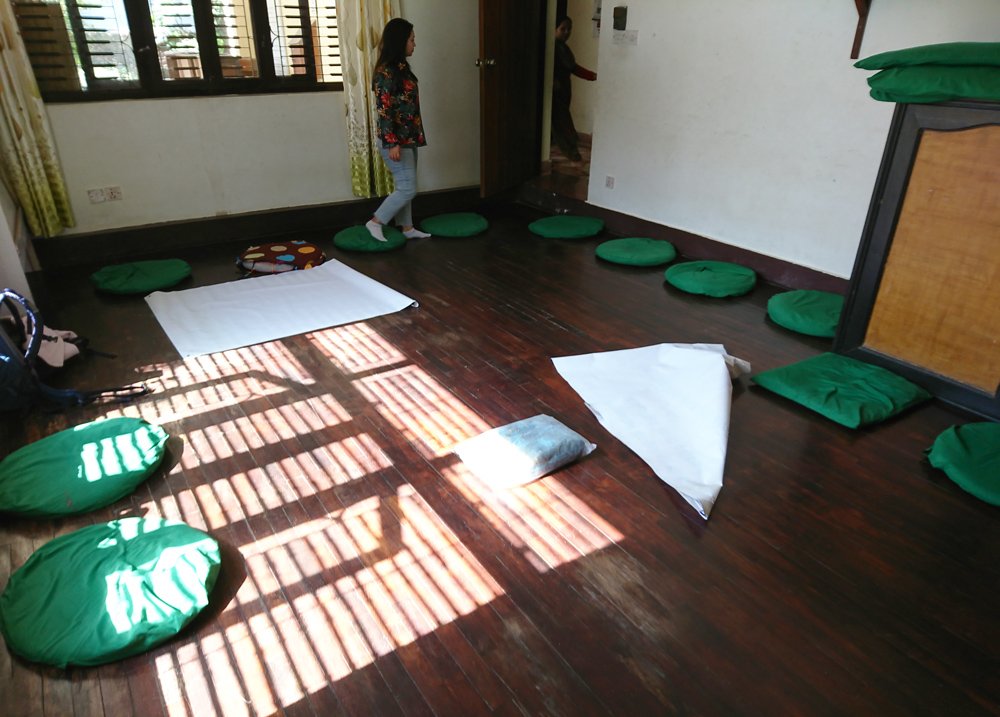Published:
March 2023
Issue:
Vol.18, No.1
Word count:
3051
About the author
-
PhD, MCAT
Tricia is a Lecturer in Career Education in the Graduate Employment Division, Deakin University, Melbourne, Australia. Tricia has a PhD in Public Health for qualitatively exploring the reproductive health knowledge of young women who have been trafficked into the sex industry in Nepal. She is also an Australian Government Endeavour Research Fellow, the funding of which enabled her to complete her PhD fieldwork in Nepal. Prior to her PhD, Tricia was a creative arts therapist who worked in the women’s reproductive health sector in Melbourne.
This work is published in JoCAT and is licensed under a CC BY-NC-ND-4.0 license.
-
Ong, T. (2023). Mandala: Reflecting on my experience of the embodiment of Tibetan Buddhism in the moulding of mato (clay) with women in Nepal and Australia. JoCAT, 18(1). https://www.jocat-online.org/c-23-ong/
Mandala: Reflecting on my experience of the embodiment of Tibetan Buddhism in the moulding of mato (clay) with women in Nepal and Australia
Tricia Ong
Abstract
In Tibetan Buddhism, a mandala (circle) is a tool for gaining wisdom and compassion and for guiding individuals on a path to enlightenment. In this article, I reflect on my experience of the embodiment of Tibetan Buddhism in the moulding of mato (clay) with women in Nepal and Australia. It begins with an art therapy experience and mato around the (Tibetan Buddhist) Shechen Tennyi Dargyeling Monastery, Boudhanath, Nepal, and circles back to a ball of prakritik mato (natural clay) in the art therapy studio at La Trobe University, Melbourne, Australia. What sits between is a pathway to enlightenment…
Keywords
Art therapy, clay body-mapping, Clay Embodiment Research Method, Nepal, Tibetan Buddhism
Tricia Ong has provided an extensive photo documentation to accompany her written reflection below. Please click through the images and you can also refer back to them while you read.
You can also listen to a podcast interview with Tricia, and read a review of her 2023 book, A feminist approach to sensitive research: Designing the Clay Embodiment Research Method.
(Tibetan Buddhist) Shechen Tennyi Dargyeling Monastery, Boudhanath
In 2011 I was working as a creative arts therapist with Art to Healing on a women’s empowerment project in Nepal (see Ong, 2013, 2023). We stayed in a garden and guesthouse with a bird-filled garden in the grounds of the (Tibetan Buddhist) Shechen Tennyi Dargyeling Monastery, Boudhanath (Figure 1). Boudhanath is known locally as Little Tibet because of the large populations of refugees that live in the area and the construction of over 50 gompas (Tibetan monasteries) around Boudha.
Along with hearing dogs bark at night, I remember being woken at 4am by a bell signifying the morning prayer ritual of the Tibetan Buddhist monks. One day I sat lotus style in the monastery listening to the monks chanting their mantras and realised that I had been drawn into a meditative state during which I became aware that my heart rate had slowed. I also recall cheekily echoing the laughter of a monk on the pathway back to the guesthouse and realised the universality of laughter to bridge a cultural divide. Humour has since become a big part of my experiences in Nepal and it is often through remembering humorous scenarios that I recall Nepali words. And it is all thanks to the Tibetan Buddhist monk.
Boudhanath Stupa
Every day on the project we walked through the grounds of the monastery and down a wending pathway to the Boudhanath Stupa (Figure 2). A stupa is a three-dimensional reminder of the Buddha’s path towards enlightenment and various parts of it represent earth, water, fire and air. The spire has 13 levels, which signify the stages a human being must circumnavigate to achieve nirvana (religious enlightenment). In the evening, we would often return at dusk and get caught up in the frenzy of Tibetan pilgrims doing their evening kora (circumambulations) clockwise around the stupa, spinning prayer wheels (Figure 3) and mala (prayer) beads, and lighting butter lamps (Figure 4). I always found the internal uttering of the mantra on the prayer wheel, om mani padme um, which is commonly translated as ‘The jewel is in the lotus’, to be moving. The Dalai Lama, spiritual leader of Tibet, translates the mantra’s greater meaning as the path to achieve the pure body, speech and mind of a Buddha. The lighting of the butter lamps is an offering of wisdom and light of knowledge to eradicate darkness or ignorance.
When I first heard a hauntingly beautiful musical version of the Tibetan incantation of om mani padme hum, I bought a copy of the CD. Upon listening to it in Australia, I am always transported back to circumambulating the Boudhanath Stupa, spinning prayer wheels and mala beads, and lighting butter lamps. It centres me, and the Boudhanath Stupa is place I always circle back to when in Nepal.
Three experiences of clay work with women in Nepal
१ (1). Mato: Art therapy, sex-trafficked women and clay work in Nepal
On the Art to Healing women’s empowerment project, I co-facilitated a five-day art therapy and women’s reproductive health training program with sex-trafficked women, which incorporated a mato (clay) workshop and a photography workshop. I left the art therapy field after this to pursue a PhD in Public Health (see Ong, 2013), exploring the reproductive health knowledge of young women who have been trafficked into the sex industry in Nepal (see Ong, 2018). Clay became central to my research. On the training program, I met Smriti Khadka, the Manager of Asha Nepal, a UK charity and Nepalese non-governmental organisation that works with sexually abused and sex-trafficked women and girls (see https://asha-nepal.org/). Asha Nepal became my primary research partner in Nepal (see Ong, 2023).
२ (2). Mato ko khel (play with clay): The Clay Embodiment Research Method and reproductive health research with sex-trafficked women in Nepal
I designed the Clay Embodiment Research Method (CERM), which uses body mapping in three dimensions using clay and photography of the clay work-group interviews, as a culturally sensitive method for my research (see Ong, 2020, 2023). In Nepal, the method is fondly known as mato ko khel, which means ‘play with clay’ (Ong, 2023).
The CERM has roots in clay in therapy and use of clay in Nepal, such as its use in Hindu religious rituals (see Ong, 2023). As clay connects to the body, it can elicit trauma (Elbrecht, 2012; Ong, 2023; Sherwood, 2004). Despite trauma emergence through clay body-mapping and associated photography, the CERM was powerful for our body-related research with the six women who participated in our research: Aisha, Indira, Niuresha, Rosina, Soniya and Sulob (pseudonyms chosen by the women or by us). The use of the multisensory material of clay was a perfect match for our sensory literate women’s ways of knowing. In Nepal, we sourced local clay from the village of Thimi and bought diyos (oil lamps made from clay, which are used in religious rituals) to use as water vessels. The women used hand-sized balls of clay and worked in a circle, seated on cushions on the floor. Plastic mats from Australia prevented clay residue from seeping onto the floor. After using the clay in Nepal, we always moulded it back into hand-sized balls for its next use.
३ (3). Prakritik mato (natural clay): Clay body-mapping with the women of Asha Nepal
Since living in Nepal from late November 2015 to April 2016, Sabrina Chettri, my former research assistant, and I had been hoping to do more clay body-mapping with women in Nepal. In October 2022, a window of opportunity opened during the Covid-19 pandemic. I flew to Nepal and we co-facilitated a clay body-mapping workshop for 12 women at Asha Nepal (made up of ten staff members, a former counsellor and former social worker) as part of a small launch for a book I had written on the CERM during lockdowns in Melbourne (the royalties are going to Asha Nepal). The focus of the workshop was doing clay body-mapping to enable the women who work with sexually abused and sex-trafficked women to express how they experience stress in their bodies and where they go to relax. At Sabrina’s suggestion we named the workshop afnu lai maya, which means ‘love yourself’.
Preparing for the workshop was a memory-filled experience for me because of the clay. Before I flew to Nepal, Smriti sent me photos of my old fieldwork mato, which had been left with the former staff counsellor of Asha Nepal to use with their girls (Figure 5). It stirred memories of Aisha, Indira, Niuresha, Rosina, Soniya and Sulob using hand-sized balls of clay to sculpt their bodies.
The clay looked hard. so Sarita Dongol, an artist friend of mine, got some prakritik mato (natural clay) for me, which she said would be good for our hands. She left it at Newa Chen, an old World Heritage-listed guesthouse in Patan, while I was out trekking in the Himalayas (Figure 6).
When I went to pick up the clay, I was excited to see it after we finally found it behind a stool in Newa Chen’s reception (Figure 7).
Being at Newa Chen stirred memories of all the Hindu religious rituals I had experienced at the guesthouse, the place of refuge it was for me while living in Nepal, and the moment Sabrina and I did some final clay work in the gazebo off the courtyard before going home to Australia. I left the field (Figure 8). I also remembered that this was where I first met Sarita.
As the clay was heavy (10 kilos), I had placed it on a sukul (straw mat) (Figure 8). I stepped into the courtyard and turned around to look at it. It looked like I had placed the clay on an altar like an offering (Figure 9).
The clay was wrapped in blue plastic so I could not see or touch it. The colour reminded me of the ocean in Australia (Figure 10). I remembered Aisha doing clay work and sharing her experiences of her husband’s violent behaviour towards her and her daughter (see Ong, 2022; Ong et al., 2019, 2020, 2021).
I put the clay in my new ocean-blue backpack to take to Asha Nepal (Figure 11). I was meeting Smriti the day before the workshop to catch up and take photos of the room we were running the workshop in so I could show Sabrina later in the day.
As I put my backpack on, I did a little dance for joy (Figure 12). I was excited about what happens in clay, but this time I felt fully prepared.
I took a taxi to Asha Nepal because the clay was too heavy to transport any other way (Figure 13). It felt luxurious, as I had carried smaller amounts of clay everywhere in a backpack while living in the field due to a fuel crisis which made taxis expensive.
I put my backpack on the back seat of the taxi. I rested my hand on it and it soon became warm. Then I realised I was protecting the clay, just as I had done in the field after the women had begun using it and we would mould it back into hand-sized balls (Figure 14).
The driver got lost trying to find Asha Nepal because Google maps does not work very well in a city whose streets are largely unnamed (Figure 15). However, the experience was fun and I could wait to hear the squeaky gate at Asha Nepal and see Smriti’s smiling face.
At Asha Nepal, Sarita, Indira, Uma, Smriti and I shared (lots of) masala chia (spiced tea) and khanna (lunch), and Kusum joined us on WhatsApp so we could talk about the workshop (Figure 16). We spoke in Nepali, English, or a broken mix of the two, about memories from the field in 2016 to more recent times with Covid-19. The time passed all too quickly.
I also took photographs of the room for the workshop. The wooden floors radiated warmth from the sun (Figure 17).
After saying goodbyes, I went to meet Sabrina at Dhokaima Café in the old city of Patan (Figure 18). We were so excited to see one other after almost three years that we hardly discussed the workshop. However, we intuitively knew that everything would come together on the day because of our fieldwork experience.
On the day of the workshop, I picked Sabrina up in a taxi so we could go to Asha Nepal together. I initially could not see her at the designated pick-up point. We laughed about this as it was just like old times and I diarised the moment with a cheeky taxi photo (Figure 19).
At Asha Nepal Sabrina and I set up the room together (Figure 20). We created a mandala of cushions on the floor, just as we had done in the field. Sunlight drenched the room.
Sabrina unpacked the clay and two women from Asha Nepal helped her mould it into hand-sized balls, just as we had done in the field (Figure 21). I touched the clay and exclaimed, “It’s so soft!”
Smriti got the old plastic mats from our fieldwork, and Sabrina and I also cut up some old plastic ‘flex’ posters to protect the floor (Figure 22). We later filled little plastic cups with pane (water) so the women could moisten the clay if it dried out while they were using it.
When women came into the room to begin the workshop, they sat lotus style on the cushions on the floor and spontaneously began to play with the clay (Figure 23). Sabrina and I looked at one another and quietly expressed delight.
The warm-up had begun and the women and centred themselves. Sabrina and I had to pause their engagement to give them workshop instructions and tell them that clay can elicit trauma. (This was important because sexual violence is a big issue for women in Nepal and it sits ‘just beneath the surface’ with clay.) Smriti assured the women that she and the staff counsellor were there if anything happened. In Nepali, Sabrina led the group and there was an initial circuitous flow of conversation as they started to work with their hand-sized balls of clay. Then the room became meditatively silent. However, in the sharing session afterwards the conversation was explosive, as the women shared – using their clay sculptures and their bodies – their felt sense of how and where they experience stress in their bodies (mind, neck, legs, etc.) and where they go to relax (cooking or doing housework at home, gym, cycling, television and temple). It was an impressionable moment as, once again, we could see how men impact on the daily lives of Nepalese women.
The former staff counsellor of Asha Nepal said the experience of sculpting with the clay in a circle on the floor was “intimate” (Figure 24).
After the workshop, Sabrina and I helped the women to mould the clay back into hand-sized balls and wrap it in plastic for its next use at Asha Nepal. I wrapped one up to take home to Australia, just as I had done after living in the field. As the women cleaned up the room, I remembered an experience from Australia, where I had observed Tibetan Buddhist monks create a sand mandala. Once it was complete, they ritualistically swept up the coloured sand. This ritual symbolises the Buddhist concept of the impermanence of everything (Figure 25).
After the workshop, we all shared khanna. I read the preface of my book and Sabrina’s extract in it. Then Smriti and I cut a ‘Happy Book Launch’ cake and made a promise: to write a new book together about the women she has worked with at Asha Nepal (Figure 26).
Sabrina and I said our goodbyes to Smriti and the women of Asha Nepal. Then we honoured a promise to ourselves, which was to go somewhere and share a meal. However, we were undecided as to where. “What about Boudhanath Stupa?” Sabrina suggested. It was at the Boudhanath Stupa at dusk (Figure 27) that Sabrina, her husband Subud and I circumambulated the stupa. We watched the lighting of butter lamps (Figure 28) and Subud spun prayer wheels (Figure 29). Om mane padme um. It was a reverential closing of a day…
Circling back to the Boudhanath Stupa
Before leaving Nepal, I returned to the Boudhanath Stupa. I found myself staring into the all-seeing eyes of Buddha (Figure 30), sharing in the lighting of the butter lamps (Figure 31) and circumambulating the stupa in a clockwise direction while the Tibetan pilgrims were spinning prayer wheels and turning mala beads (Figure 32). It was profoundly moving… and…
The art therapy studio at La Trobe University: Tibetan Buddhism, clay, two women, and a hand-sized ball of prakritik mato from Nepal
In 2021, Covid-19 lockdowns in Melbourne, Australia, decentred me. While I was writing my book, I felt a knead to re-engage with clay. In March 2022, I began a hand-building and wheel-throwing pottery class at The Clay Room at Camberwell Community Centre. It was a ‘delicious’ experience and I began to feel revived. During this time, I began to have ‘clay conversations’ with Theresa Van Lith, course coordinator of Art Therapy at La Trobe University. In June 2022, we met and discovered a common interest in clay. In the flow of conversation, she helped me to consolidate my thoughts on the CERM and the need for training in its use (i.e., in body mapping, the therapeutic use of clay and associated photography) on the last page of my book. Soon after, I completed the book.
Later, I shared my Nepal plans with her. In November 2022, after I returned to Australia from Nepal, the two of us met in the art therapy studio at La Trobe University. I took my one hand-sized ball of prakritik mato from Nepal (Figure 33). At an intentional moment, I opened the bag… and out spilled memories of circumambulating the Boudhanath Stupa, Smriti and the women of Asha Nepal, and centring…
Acknowledgements
Danyabad (thank you) to Sarita Dongol for getting such nurturing prakritik mato for our clay body-mapping. Tik cha (perfect).
References
Elbrecht, C. (2012). Trauma healing at the clay field: A sensorimotor art therapy approach. Jessica Kingsley.
Ong, P. (2018). Reproductive health for the marginalised: The knowledge of young women trafficked into the sex industry in Nepal. (Publication No: 21112780) [Doctoral dissertation, Deakin University]. DRO. https://dro.deakin.edu.au/articles/thesis/Reproductive_health_for_the_marginalised_the_knowledge_of_young_women_trafficked_into_the_sex_industry_in_Nepal/21112780
Ong, T. (2011). From out of the shadows: A creative arts therapist’s reflections on bringing endometriosis into the arts therapy milieu. ANZJAT, 6(1), 91–100.
Ong, T. (2013). Nepal – three cups of tea: Ruminating on the writing in the leaves. Creative Approaches to Research, 6(3), 48–56.
Ong, T. (2023). A feminist approach to sensitive research: Designing the Clay Embodiment Research Method. Routledge.
Ong, T., Mellor, D., & Chettri, S. (2019). Multiplicity of stigma: The experiences, fears and knowledge of young trafficked women in Nepal. Sexual and Reproductive Health Matters, 27(3), 32–48. https://doi.org/10.1080/26410397.2019.1679968
Ong, T., Mellor, D., & Chettri, S. (2020). Clay as a medium in three-dimensional body mapping. Forum: Qualitative Social Research/Sozialforschung, 21(2). https://doi.org/10.17169/fqs-21.2.3380
Ong, T., Mellor, D., & Chettri, S. (2021). ‘Females are always dominated and disregarded by males, just because they are female’: The continuation of patriarchal norms for young trafficked women in Nepal. Culture, Health & Sexuality, 1–16. https://doi.org/10.1080/13691058.2021.1949495
Sherwood, P. (2004). The healing art of clay therapy. ACER Press.


































